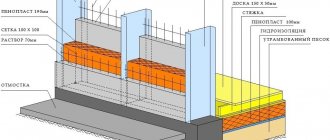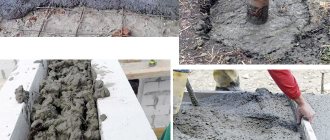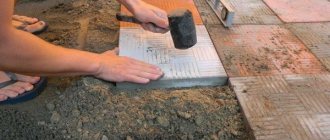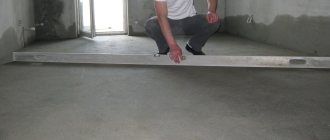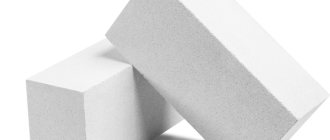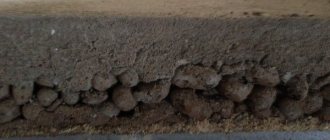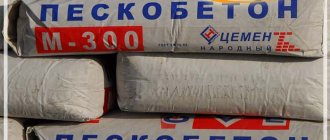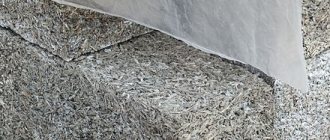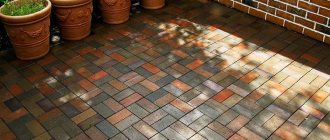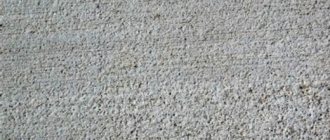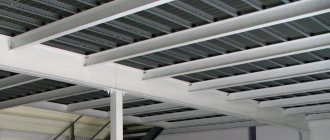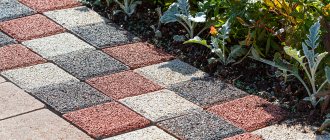4046
Among the many building mixtures, sand concrete M 300 occupies a special place, as it has a number of advantages over its concrete counterpart:
- hardens faster;
- does not shrink;
- not afraid of frost and moisture;
- easy to use;
- affordable;
- resistant to temperature changes.
Available in 50 kg bags, which is convenient for transportation, loading and unloading. Material is shipped from warehouses in such bags.
Sand concrete bags
Composition and types of sand concrete M300
In accordance with the state standard, dry sand concrete mixture grade M300 includes Portland cement M300, dense river sand of fine (0.5 mm) and coarse fractions (no more than 3 mm) and a set of modifying additives. Among these, the mixture may contain plasticizers that reduce hardness and increase the frost resistance of the solution, anti-corrosion components, granot sieving, and sometimes small crushed stone. The indicator “300” in the marking of the material indicates its tensile strength, expressed in kg per 1 cm2 after final hardening (after 28-30 days).
Depending on the ratio of the components that make up the material and the fractionation of the filler, dry sand concrete M300 is divided into three types:
- fine-grained (0.5-2.0 mm), used for primary plastering of surfaces and sealing joints;
- medium fraction (2.0-2.2 mm), used for laying bricks, building blocks and paving slabs, forming screeds and poured floors;
- coarse-grained (2.2-3 mm), suitable for pouring shallow monolithic foundations and installing reinforced concrete structures.
The homogeneity and standardized composition of the initial mixture, as well as the plasticity of the diluted solution, ensure uniform filling of the cavities, eliminating its caking and undesirable concentration in certain areas of the working volume. The best adhesive qualities of the material are manifested when it is applied in a layer of 10 to 50 mm. If the thickness is greater, the setting period increases. In this case, be sure to use a masonry mesh. The certified setting time of M300 sand concrete (for a 10 mm layer), regardless of the type, is 120-180 minutes with the viability of a freshly prepared solution within 120 minutes. The mixture reaches its maximum strength 28 days after installation.
Composition of sand-concrete composite
Sand concrete M300 is not difficult to prepare. The composition is determined by GOST 31357. In industrial conditions, the material is prepared from the following ingredients:
- Portland cement grade M500 – 1/3 of the total volume;
- multi-format sand – 2/3;
- crushed stone in a volume optimal for giving the batch a rigid structure (in this form it is used when it is necessary to make a foundation;
Additives (plasticizer, modifier) are used that improve performance properties.
For interior work, it is more advisable to use a mixture with the M150 cement grade, since the surface of the floor base is less susceptible to negative environmental influences.
The recipe proportions of M300 sand concrete give it special strength for environmental conditions - winds, precipitation, temperature changes. But if desired and financially possible, it can also be used for interior work.
Areas of application of sand concrete M300
Due to its low price and ease of dilution, sand concrete M300 belongs to the most popular modern building materials and is widely used in the process of preparing masonry mixtures for bricks and reinforced concrete products, when pouring reinforced belts and foundations, erecting monolithic structures and arranging stairs, during repair work and landscaping of local areas.
In addition to its main purpose, M300 grade sand concrete can be used as a base or an additional component of more complex building mixtures: cement insulation mortars, expanded clay concrete, reinforced concrete, etc.
Application of sand-concrete substrate
Sand concrete M300 as a universal composition is used in many areas of construction work. Since its appearance on the market in 2007, it has firmly taken its place among the popular materials and is used for:
- house foundations;
- installation work;
- sealing large cracks in ceilings and walls;
- as a mixture for floor screed.
The density of sand concrete M300 allows you to obtain high-quality external and internal surfaces.
Sand concrete with a value of 300 can be used in the manufacture of curbs, stairwells, and paving slabs.
Accelerated hardening increases the demand for use in emergency work when urgent repairs are required. Convenient when sand concrete screed dries quickly.
Mixing sand concrete
Pouring the foundation
Working qualities of the material
Among the performance characteristics of M300 grade sand concrete, the following are considered the most interesting and attractive:
- excellent strength of the finished coating, guaranteeing, depending on external conditions, up to 30-50 years of its operation without major restoration operations;
- absolute absence of corrosion, frost and moisture resistance, mechanical endurance;
- absence of cracks and shrinkage during hardening, high density of the frozen solution.
GOST R and construction regulations do not provide for a clear division into masonry, plaster and installation mixtures of grade M300. Here we should proceed from the priority nature of the work and focus, first of all, on the fractionation of large particles of the material. The optimal equipment for mixing the solution is a construction mixer or concrete mixer. For small scale work, a manual method is possible.
Areas of use
M300 sand concrete products are widely used in the construction of low-rise buildings. Since the building material is environmentally friendly and has improved characteristics, its scope of application is wide. The characteristics of sand concrete M 300 are influenced by the bulk materials with different fractions included in the composition. For example, a dry mixture with dense and stable qualities consists of fine-grained elements that do not exceed 2 millimeters. Such mixtures have increased strength; they are used to seal seams and are used for exterior finishing.
Dry mixture M300 sand concrete, which includes fractions with sizes of 2-2.2 mm, is most suitable for the construction of curbs, pedestrian paths, and self-leveling floors. The grain size index indicates good thermal insulation qualities, for this reason this building material is popular in arranging the bases for various floor coverings. Sand concrete composition is also used as a self-leveling material, the cost of which is much lower when compared with special solutions. Due to its quality that eliminates shrinkage, the areas of application of M300 sand concrete allow the solution to be used in conditions with difficult soil. For example, in cases of unstable and unstable soil.
High strength indicators and technical characteristics allow the mixture to be used in the following construction areas:
- Arrangement of foundations. Especially when pouring strip bases, and in cases where long-term operation is required.
- Concreting of production sites with the most loaded industrial enterprises. The finished material of the M300 brand has excellent wear resistance.
- In the process of creating reinforced concrete structures and as the bulk of the design of concrete stairs.
- Creating a wear-resistant floor in areas with high loads, for example when building garages.
- For arranging a blind area.
- In the production of paving slabs and border elements. Sand concrete is also suitable for laying tiles.
- The mixture is suitable for reliable and durable sealing of joints.
- For fixing block products and slabs.
- Sand concrete is used for laying bricks and cinder blocks.
- Due to its light weight, the building material is suitable for the construction of buildings with a small number of floors - private houses, utility rooms.
Finished surfaces, after hardening, can be easily processed with various finishing options. With sand concrete M300 no additional waterproofing is required. Any work using this solution will be more economical compared to foam concrete or brick.
Selection of sand concrete M300 and calculation of its consumption
With an even application of masonry mortar based on sand-cement mixture M300, if the working layer has a thickness of about 10 mm, 18-20 kg of dry material is consumed per square meter. Laying floor slabs will require double the consumption rate, since according to SNiP the mortar layer must be at least 20 mm. Here you should remember about the presence of cracks and voids in bricks and blocks, the filling of which will require additional material.
If there are cracks, cavities and differences in the treated area, the average thickness of the layer of diluted sand concrete is preliminarily calculated. To do this, a series of measurements should be taken at different points of the site or room relative to the most protruding part of the structure. Having determined the absolute deviation from the maximum (the largest difference between the top and bottom), the resulting value is divided by two and the average thickness of the mortar layer is obtained. In order to avoid excessive consumption of material and its repeated application, the working surface must be cleaned of grease, dust and paint in advance, and all crumbling parts must be removed.
When choosing the type and manufacturer of sand concrete M300, it is useful to pay attention to the passport characteristics of a particular building material and its components, which is indicated on the factory packaging of the mixture. It is advisable to pay attention to products that meet not only industry specifications, but also GOST R, which is also reflected on the label. For large-scale work, it is advisable to purchase material packaged in 50 kg big bags, which helps save money. On the other hand, sand concrete is offered to private consumers for carrying out minor repair procedures in packages of 35, 25 and less kilograms.
Pre-packaged sand concrete should be stored in dry, warm rooms without contact with the ground, preferably on wooden pallets. In this case, the shelf life of the M300 mixture guaranteed by the manufacturers without loss of consumer qualities is at least a year from the date of manufacture.
Dependency on weather conditions
Concreting in different weather conditions requires different times for the mixture to harden.
So, for example, the answer to the question of how long it takes for a concrete foundation to dry at a temperature of no more than +5 degrees will be twice as long as the period for the foundation to harden at a temperature of +20.
Foundation diagram
Well, if the temperature outside drops to zero, then the question of how long it takes for a concrete screed to dry outside will not be answered by any specialist, because in such conditions the process of strengthening the solution practically stops.
The mixture, of course, will harden sooner or later, but due to the freezing of water, a capillary system of pores is formed in it, which subsequently expands moisture during freezing and will lead to cracking of the monolith from the inside.
That is why experts do not recommend concreting in winter, or doing it only using specialized anti-frost additives.
But the summer period, in turn, also has some negative effects on the solution. High temperatures during this period can cause premature drying of the mass, which can lead to deformation of the finished product.
During this period, it is necessary to pay special attention to the processes of moistening the building mass or use quick-drying Portland cement.
It is important to remember that the hardening of the solution occurs in the first few days after pouring and it is this time that is associated with the main increase in strength of the concrete product.
Description
The cement mixture is intended for finishing and repair work. The composition of sand concrete includes clay, limestone, sand. General characteristics of sand concrete M300 are given in the table.
| Name of parameters | Meaning |
| Compressive strength, MPa | 30-40 |
| Color | Grey |
| Adhesion strength at separation, MPa | 0,3-0,5 |
| Viability of solution, minutes | 120 |
| Hardening time, hour | 24 |
| Required base temperature, degrees C | From +5 to +30 |
| Water consumption per 1 kilogram, liter | 0,18-0,23 |
| Recommended screed thickness, mm | 15 — 100 |
The packaging of the M300 mixture is mainly a standard paper bag weighing 40 kilograms.
Calculation of materials for plaster
Plaster mortar.
To save money, you need to calculate the required amount of material to complete the job. Consumption is calculated per 1 m² of wall or floor area. The easiest way is to multiply the length of the wall by its height. This is how the amount of solution is calculated for a layer thickness of 1 cm. To calculate the amount of solution per 1 m³, this figure is multiplied by 100. The components are taken according to the proportion of the mixture. The optimal proportion is 1:3. It is easy to calculate the number of bags, knowing the required amount of working mixture and its content in the bag.
For plastering, use solutions M100, M150 and M200 with the addition of a small amount of clay or lime to increase plasticity. Ready-made mixtures are sold in stores: Bark beetle, Optimist, Volma, etc. Plastered surfaces are resistant to temperature changes, have strength and adhesion to various finishing materials, and have a long service life.
